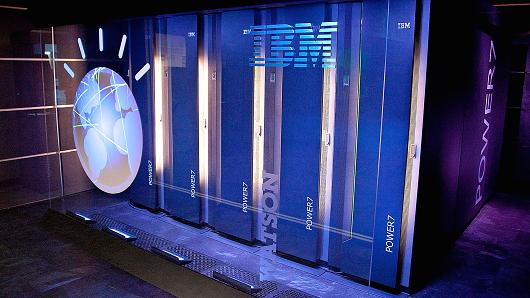IBM gives Watson a new challenge: Your tax return

In its first steps toward commercialization, IBM’s Watson took on grand, science-laden challenges like helping doctors diagnose cancer. But that is changing as IBM strives to build its artificial intelligence technology into a multibillion-dollar business.
Today, companies including Geico, Staples and Macy’s are adding the Watson technology to answer customer questions or to improve mobile apps that guide shoppers through stores.
Now in its broadest deployment so far, Watson will be assisting H&R Block’s 70,000 tax professionals this filing season at 10,000 branch offices across the country, where 11 million people file taxes.
The H&R Block partnership with Watson, announced on Wednesday, is being presented to a wider audience with a 60-second television ad during the Super Bowl on Sunday.
For IBM, the collaboration with H&R Block underlines its strategy in the emerging market for artificial intelligence technology. Watson will touch consumers, but through IBM’s corporate clients.
“Watson will become a really smart, virtual assistant,” said David Kenny, senior vice president of IBM’s Watson business.
The embedded-in-business formula is different from the path other technology companies are taking with digital assistants powered by artificial intelligence. Others are pursuing the broad consumer market directly with artificial intelligence software helpers like Siri from Apple, Cortana from Microsoft, Alexa from Amazon and Assistant from Google.
In the corporate technology market, the major companies are racing to get on the artificial intelligence bandwagon, though they lack the early lead and powerful branding of Watson.
Data-fueled artificial intelligence will be an ingredient in all kinds of software used in corporations, to streamline work, identify new customers, spot savings and guide product development, analysts say. By 2018, the research company IDC predicts that 75 percent of new business software will include artificial intelligence features.
Over time, Watson’s suggestions get better and better, more individually tailored to specific occupations, household finances and personal circumstances. “It’s crawl, walk, run learning,” Mr. Kenny said. “But the pace of the Watson learning is so much faster than humans.”
“A.I. is becoming part of the mix, part of the infrastructure in consumer and business applications,” said David Schubmehl, an IDC analyst.
IBM is also banking on Watson as an engine of its corporate transformation. The company needs its new businesses like Watson, data analysis and cloud computing to more than make up for the erosion in its traditional hardware and software products.
That has not happened yet. Two weeks ago, IBM reported its 19th consecutive quarter of declining revenue.
But there were encouraging signs in the last quarter of 2016.
IBM executives noted that the company’s newer businesses, including Watson, grew by 14 percent to represent 41 percent of total revenue. That was ahead of IBM’s previous forecast that the 40 percent of revenue threshold would not be reached until 2018.
The H&R Block collaboration suggests that IBM is getting better at working with partners. Some of the early Watson projects stretched out for years partly because of poor communications between IBM and its clients.
But when Bill Cobb, chief executive of H&R Block, contacted IBM last summer, saying he wanted to use Watson to help “reinvent the retail experience for taxpayers,” he heard what he called a candid assessment, not a sales pitch.
“This is not magic,” Mr. Cobb said the Watson team told him. “You have to teach Watson over time.”
Watson proved to be a quick learner. Its core skill is its ability to digest and classify vast amounts of text, using what is known as natural language processing. So, among other things, it was fed the 74,000 pages of the federal tax code and thousands of tax-related questions culled from H&R Block’s data, accumulated over six decades of preparing tax returns.
Then, H&R Block tax professionals were brought in to “train” Watson. They approved when Watson suggested a smart question for a particular tax filer and corrected it when a proposed question was off base. The tax professionals were not told they were working with Watson, just a software program.
The technology was tested in about 100 H&R Block offices in January, and it will be available throughout the company’s retail network next week. One goal, Mr. Cobb said, is to assist H&R Block’s tax professionals and improve their chances of fairly increasing refunds and reducing tax liabilities for clients. Seventy-five percent of Americans who file taxes get money back. For H&R Block clients, the figure is about 85 percent, Mr. Cobb said.
But Watson’s other task was to make visiting H&R Block a more “engaging and interactive” experience, he said. Clients will be able to watch suggestions and questions on a separate screen, as the Watson-assisted tax professional works.
Mr. Cobb said he was “very pleased” with Watson’s performance in the 100-office trial. But the test will come after this tax season, when H&R Block sees what percentage of customers return next year.
The retention rate is crucial in the tax-preparation business. Sixty percent of the 140 million Americans who file taxes seek help instead of doing them themselves. Kartik Mehta, an analyst at Northcoast Research, estimates that H&R Block’s retention rate is 75 percent. “If they can get that 75 percent up to 80 percent, it’s a big deal for H&R Block,” Mr. Mehta said.
The Watson collaboration is a “long-term partnership,” Mr. Cobb said. Mr. Kenny of IBM described this tax season as “phase one” of the partnership.
Source: CNBC





























